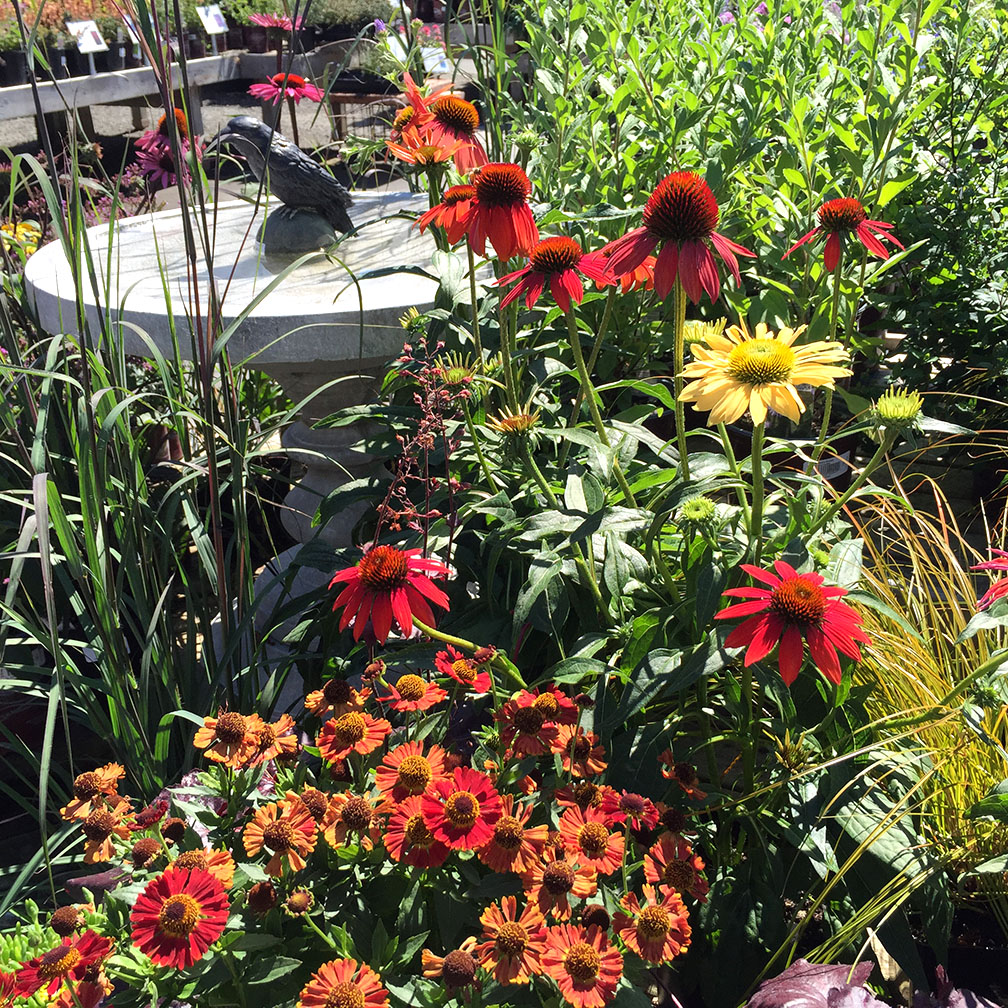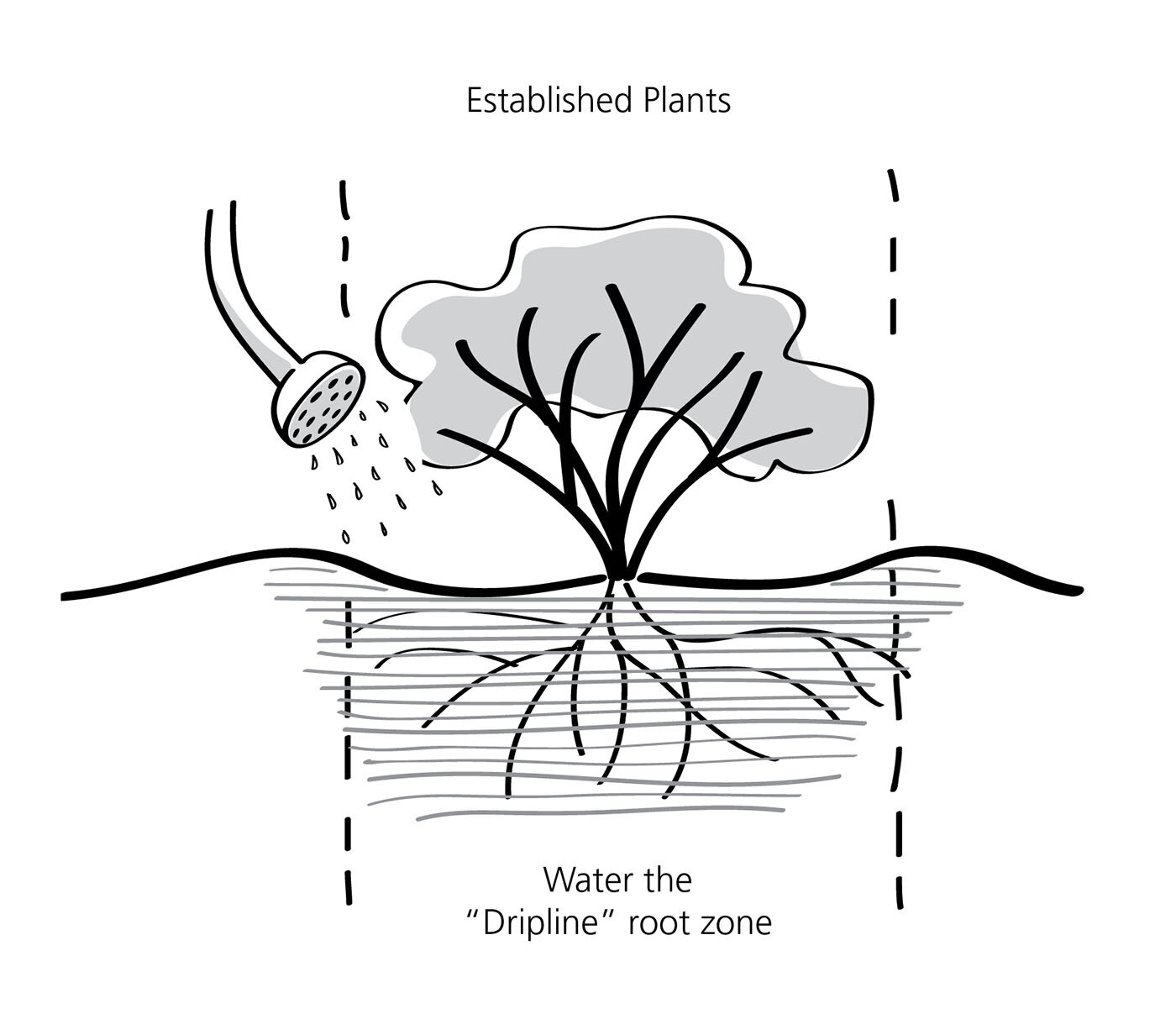Drought tolerant* or low water use* are terms we use often in Northwest gardening. You see them on many of our plant signs and information sheets at Swansons. More so each year, as we recognize the importance of saving water in the face of our region's growing population and potential effects of climate change. Also, we see ever more examples of how beautiful a well-designed, drought-tolerant garden can be!
[*Note: "drought-tolerant" plants can generally handle longer, dryer conditions than plants labeled "low water use." But the boundary between them is pretty thin (see definitions below). To simplify, we will use the more common term "drought tolerant" to refer to both types here.]
There are a lot of misconceptions about drought-tolerant plants — what they are and how to properly plant and care for them. Drought tolerant does not mean zero watering. If you are looking for "stick 'em in the ground & forget 'em," sorry, we can't help you much. Few plants will survive that strategy for long, unless they are tapping into a water source other than the gardener. Most of Swansons' signs actually say, "drought tolerant once established." We also use the more inclusive term waterwise and have a series of care sheets titled as such.
Thus, the unembellished Truth:
Drought tolerant does NOT mean ZERO watering!!! This comes with two corollaries:
#1: Drought-tolerant plants need at least two (preferably three) growing seasons of proper establishment, including regular, effective watering, to make them truly tolerant of future drought periods.
#2: Most drought-tolerant plants will need some supplemental watering during future extended drought periods, although generally less than other plants which prefer more water.
There are exceptions — plants which seem to thrive or survive for years without any help. They somehow find water on their own. But we should not expect nor count on those rare plant heroes.
Some popular drought-tolerant plants for the Puget Sound region include lavender, rosemary, juniper, sedum, rockrose, sedum, and yucca. Plants adapted to drier conditions have a variety of ways to conserve water, including fuzzy or glossy leaves (which reduce transpiration) or succulent tissue (which stores water). But our concern in establishing them is their root system — best drought tolerance for any plant is enabled when the roots grow deep so they can find water when the upper soil zone dries out.
Of course, if we ever experience a prolonged, severe drought, everything would need watering at some point. Our goal here is to prepare them for more routine dry spells.
Even the drought-tolerant plants on New York City's High Line need periodic watering. (image: Wikimedia Commons)
Some definitions
"Drought tolerant" — will survive extended periods without additional water after being established with regular water and fertilizer for two growing seasons. The plant may, however, look marginal and neglected without some supplemental watering during dry periods in later years.
"Low water use" — the plant will need periodic watering after being established, but can be minimized with the careful management of watering habits.
"Growing season" — spring-summer-fall. "Two growing seasons" essentially means two calendar years not counting winters.
"Establishing a plant" — planting and caring for a plant (especially the roots) to ensure that it can thrive with minimal intervention in the future.
HOW to establish your plants
How do you "properly establish" a plant (drought tolerant or not), and get those roots deep, for two growing seasons? Many of our resources listed below explain watering techniques more fully, but let's summarize their important points here:
• Prior to planting, prepare the soil to make it easier for the roots to grow. Dig the hole 2 to 4 times the diameter of the rootball and 1 to 1.5 times as deep. Add up to 25% compost to the backfill mix, especially if the native soil is compacted or hard to dig. This increases both water-holding capacity and air spaces allowing the roots to "breathe."
• For each and every plant in the ground, water the soil where the roots actually are right now. This means water the small root ball when the plant is new, or the diameter (at least) of the plant's branches (the "dripline") on an older plant. This goes for either watering by hand or irrigation system, which may need careful adjustment to get the water to the right spots.
• Water to saturate the entire root zone (width & depth). Make sure the water penetrates through the upper layers of crusty or powdery soil. Initially, it can be like trying to wet a dry sponge. It may take some patience and ingenuity to get the water to soak in rather than run off the top. Building a moat or saucer around the plant to keep water in place can help (see illustrations). For multiple groundcover plants, this means water each root ball, if possible, especially when newly planted.
Proper watering to help establish new plants. See a pattern here? (image: Swansons)
• Let it dry out a bit before watering it again. How long? It's hard to specify, as there are many factors; it might be a couple of days to a couple of weeks. Maybe every day during hot, dry weather. The best thing is to check the soil moisture every few days at first. Roots need a rhythm of water and oxygen. Too dry is not good — constantly wet isn't much better. Too frequent, shallow watering makes shallow roots, which may suffer during the next drought.
• Mulch the soil surface with compost or other organic material. This reduces soil water loss, helps surface water infiltrate better, and bolsters soil health and fertility.
After a couple of growing seasons, you can gradually wean your plants off the watering routine but check them occasionally for individual water needs, supplemental mulching, or other needs. By the way, this is a good routine for establishing almost any kind of plant.
Is it still worth it to plant drought-tolerant plants if they need as much pampering as other plants for the first two years? Absolutely! They still require less water and general maintenance than moisture-loving plants. We don't suggest purging your garden of moisture lovers. We merely ask you to consider the areas where drought-tolerant plants can save you a lot of future watering and work. Then take the extra steps to ensure that your plants get off to a healthy start.
Resources
Our website has a virtual flood of online and printed resources for choosing, planting, and caring for drought-tolerant plants:
Best Watering Practices for Your Northwest Garden
Protecting Your Plants This Summer: 7 Water-Wise Tips
Our Northwest Gardening Tips page has a whole section of care sheets on Waterwise Gardening.








